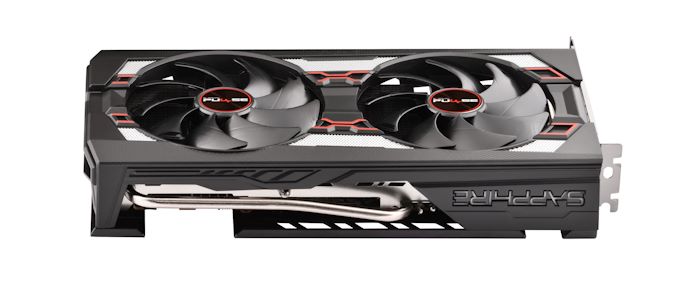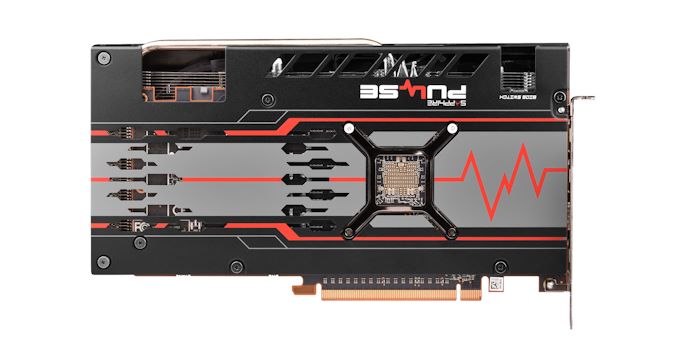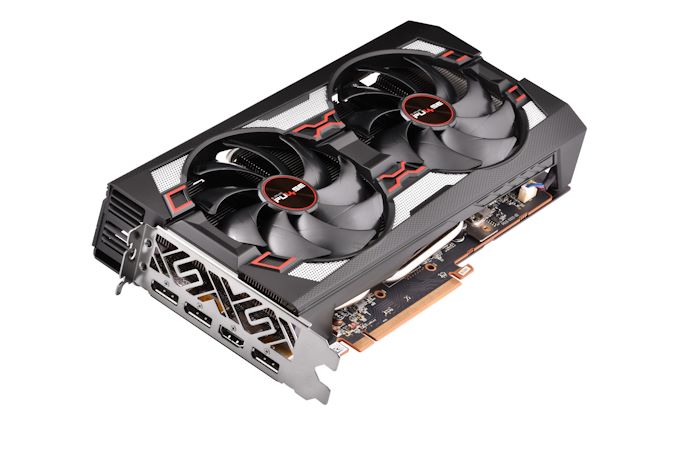The AMD Radeon RX 5600 XT Review, Feat. Sapphire Pulse: A New Challenger For Mainstream Gaming
by Ryan Smith on January 21, 2020 9:01 AM ESTMeet the Sapphire Pulse Radeon RX 5600 XT
Shifting gears, let’s talk about the actual hardware that will be hitting retail shelves today. As I mentioned towards the start of the article, AMD isn’t launching an official reference RX 5600 XT, so today’s launch is all about partner cards. To that end, AMD has sampled us with Sapphire’s Pulse RX 5600 XT. Sapphire’s card is a moderately factory overclocked card, and following AMD’s BIOS changes, is apparently a good example of what AMD wants other partner factory overclocked cards to be like.
| Radeon RX 5600 XT Card Comparison | |||||
| Radeon RX 5600 XT (Reference Specification) |
Sapphire Pulse RX 5600 XT (Quiet Mode) |
Sapphire Pulse RX 5500 XT (Default/Perf Mode) |
|||
| Base Clock | 1290MHz? | 1290MHz | 1290MHz | ||
| Game Clock | 1375MHz | 1460MHz | 1615MHz | ||
| Boost Clock | 1560MHz | 1620MHz | 1750MHz | ||
| Memory Clock | 12Gbps GDDR6 | 12Gbps GDDR6 | 14Gbps GDDR6 | ||
| VRAM | 6GB | 6GB | 6GB | ||
| TBP | 150W | ~150W | ~180W | ||
| GPU Power Limit (TGP) | N/A | 135W | 160W | ||
| Length | N/A | 10-inches | |||
| Width | N/A | 2.3-Slot | |||
| Cooler Type | N/A | Open Air, Dual Fan | |||
| Price | $279 | $289 | |||
Editor's Note: These are the specs post-BIOS update. Anyone buying the Pulse in January will want to make sure to update their card with Sapphire’s new BIOSes
Sapphire has several sub-brands of cards, including the Nitro and the Pulse. Normally the Nitro cards are their higher-priced factory overclocked cards, while the Pulse cards are more straightforward. But following AMD’s BIOS changes, that seems to have at least partially gone out the window. In any case, even with its factory overclock the Sapphire Pulse RX 5600 XT is not being positioned as a high-end card among RX 5600 XTs; at $289, it carries just a $10 premium over AMD’s MSRP.
For their Pulse RX 5600 XT cards, Sapphire has opted to factory overclock both modes for the card. The card’s default mode, which is its performance mode, ships with a ~180W TBP. This affords a rather sizable 240MHz (17%) increase in the card’s rated game clock. Meanwhile the memory clock has been increased by 2Gbps (17%) to 14Gbps. In short, in performance mode the Pulse is noticeably more powerful (and power-hungry) than a baseline RX 5600 XT.
On the flip side of the coin is the card’s quiet mode BIOS. This BIOS uses settings much closer to AMD’s own reference specs, with the 150W TBP and 12Gbps matching AMD’s. The only change here is that the card gets a milder 85MHz (6%) factory overclock, as far as the game clock is concerned.
Digging into the card, it’s clear from the start that Sapphire has overbuilt the card, particularly for cooling performance. At 10-inches long the card isn’t especially lengthy, but Sapphire makes up for that with a 2.3-slot wide cooler design and significantly taller (5.3-inch) frame. Comparing it to NVIDIA’s relatively compact dual-fan GeForce RTX 2060 Founders Edition, the Sapphire Pulse RX 5660 XT has about 50% more volume. Which, along with making the card a bit of a pain to install, affords it a lot more volume for heatsinks and fans.
The payoff for this oversized design is that Sapphire can use larger, lower RPM fans to minimize the fan noise. The Pulse 5600 XT packs 2 95mm fans, which in our testing never got past 1150 RPM. And even then, the card supports zero fan speed idle, so the fans aren’t even on until the card is running a real workload and starts warming up. The net result is that the already very quiet card is completely silent when it’s idling.
Meanwhile beneath the fans is a similarly oversized heatsink, which runs basically the entire length and most of the height of the board. A trio of heatpipes runs from the core to various points on the heatsink, helping to draw heat away from the GPU and thermal pad-attached GDDR6 memory. The fins are arranged horizontally, so the card tends to push air out via its I/O bracket as well as towards the front of a system. The card also comes with a metal backplate – no doubt needed to hold the oversized cooler together – with some venting that allows air to flow through the heatsink and out the back of the card.
Feeding the beast is an 8-pin external PCIe power cable, as well as PCIe slot power for its electricity needs. From a practical perspective this is well-provisioned for a card that will hit 180W, and with the design presumably being recycled from a 5700 series design, there’s room for a second power connector if Sapphire ever needed it.
Finally for hardware features, for display I/O we’re looking at a pretty typical quad port setup. Sapphire has equipped the card with 3x DisplayPort 1.4 outputs, as well as an HDMI 2.0b output. With daisy chaining or MST splitters, it’s possible to drive up to 6 monitors from the card.














202 Comments
View All Comments
SilthDraeth - Tuesday, January 21, 2020 - link
Er... 2nd sentence. Anyway.koekkoe - Tuesday, January 21, 2020 - link
25 percent fan speed - How many RPM this is?Ryan Smith - Tuesday, January 21, 2020 - link
~750 RPM.kobblestown - Tuesday, January 21, 2020 - link
Thanks for including an R9 390X. I actually have one of those.maroon1 - Tuesday, January 21, 2020 - link
So equal price per dollar to RTX 2060But why would I buy 5600XT when the price difference too small, and I get slightly faster card with more features like DLSS, ray tracing and VRS ??
RTX 2060 is clearly better card to buy out of the two
maroon1 - Tuesday, January 21, 2020 - link
*Performance per dollar I meanKorguz - Tuesday, January 21, 2020 - link
really depends on your usage... for ray tracing, meh.. at the entry level, the 2060 is almost useless for RT, unless something has changed in the last few months, to big of a hit to use it. but looking at the prices for the 5600xt, 2060 and 2060S, at least with Asus' cards, there is $40 cdn difference between the entry card for these 3, and at the top end for these 3 cards there is an almost $200 cdn price difference, and yes, the 2060S is the most expensive at $650. for me, i would go with the 5600xt, only because i dont play, and dont plan on playing any games that use RT, so that is a feature i could care less about right now. it really boils down to what a person would do with the video card they were to get....Irata - Tuesday, January 21, 2020 - link
If it's better for you, go get it.That said, the 5600XT is still cheaper, if only by a few $, but you get only slightly lower fps (depends on the game engine really, some are quite a bit faster on the 2060, others quite a bit faster on the 5600 XT).
On the plus side, you get lower noise, lower power consumption and it's not that Navi does not have any other features.
Afaik, the one that really makes a difference in the 2060's favor is Ray Tracing, which only gives playable fps at lower resolutions on that particular card.
So really, it comes down to preference. If you can get a 2060 Founder's edition for $299 including shipping then hey, not a bad buy.
If you get a Sapphire or similar OC RX 5600XT for $289 - hey, also not a bad buy.
eva02langley - Tuesday, January 21, 2020 - link
Honestly, DLSS and RTX are not even a matter. It is in what...? 5 games? Also, a 2060 RTX is definitely not enought for Ray Tracing unless playing at 720p 60Hz is your thing.Cooe - Tuesday, January 21, 2020 - link
Lol, the 2060 is absolutely useless for ray-tracing, so if that's the reason anyone is buying one, you are absolutely doing it wrong. And DLSS is literally a game dehancer, not enhancer.